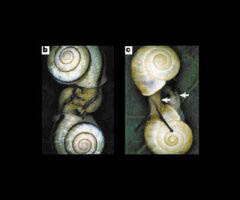필자가 찾아볼 수 있었던 가장 최근의 자료에 의하면 현재까지 4천8백여개의 소행성들이(주로 화성과 목성 사이에서 태양궤도를 도는 조그마한 천체들) 알려져 있다. 뿐만 아니라 새로운 소행성들이 계속해서 발견되고 있다.
그것이 뭐가 중요하냐고? 우선, 소행성들은 어쩌면 태양계에서 가장 오래도록 변함없는 물체들이다. 이들은 너무 작아 바다나 대기권 등 그들에게 변화를 초래할 수 있는 게 아무 것도 없다. 40억년이라는 나이에도 불구하고 말이다. 이는 즉 소행성들을 연구하게 되면 태양계의 시초나 태양계가 어떻게 형성될 수 있었는가에 대해 많은 내용들을 알 수 있을는지도 모른다는 것을 의미한다.
너무도 작아 빛의 점들로밖에 보이지 않는 이 천체들로부터 무엇을 발견할 수 있겠느냐고? 한가지 확실한 것은 소행성들이 햇빛을 반사한다는 점이며 우리는 시간이 지나면 반사되는 빛에 얼마나 차이가 생기는지 상당한 정밀도로(요즘은) 관찰 할 수 있다. 보편적으로 반사되는 빛의 차이는 소행성들이 공전하기 때문이며(우리가 아는 모든 천체들은 공전한다) 다른 곳에 비해 보다 밝게 보이는 지점이 있다고 믿어진다.
이러한 유형의 관찰은 소행성들이 얼마나 빨리 공전하고 있는지를 밝혀준다.
우리는 어떤 소행성들은 다른 소행성들보다 상대적으로 더 어둡게 빛나며 어두운 소행성일수록 태양으로부터 멀리 자리잡고 있음을 알 수 있다. 이 또한 태양계 초기에 대한 힌트를 제공한다.
소행성들의 궤도상의 간격엔 공백들이 있으며 이는 흔히 이를 발견한 천문학자의 이름을 따서 '커크우드의 공백'이라고 불린다. 소행성들은 이러한 공백 등에 따라 집단으로 분류된다. 태양계의 시초에 이 소행성들은 충돌에 의해 생겨났고 각 집단은 보다 큰 소행성들로부터 깨져나온 것일 가능성이 있다. 물론 확실히는 모르는 일이다.
소행성들은 또한 측정가능한 적외선을 반사시킨다. 이로부터 우리는 적외선의 명도와 일반적 명도라는 두가지의 지식을 얻게 된다. 이 지식들도 각 소행성이 얼마나 크며 얼마만큼의 빛을 반사하는지를 파악하는데 도움을 준다.
소행성들의 모양은 어떻느냐고? 아주 가끔씩 소행성 하나가 별하나의 앞을 지날때면 수초동안 별빛이 사라지곤 한다. 그 별빛이 사라지는 시간을 고려하노라면 우리는 소행성의 너비를 판단할 수 있다. 만약 동시에 여러명이 이를 관찰한다면 관찰위치에 따라 소행성의 너비에 얼마나 차이가 생기는가를 알 수 있게 되고 이로부터 소행성의 모양을 파악할 수 있다. 결과적으로 대부분의 소행성들은 그 모양이 매우 불규칙한 것으로 알려져 있다.
모든 소행성들이 화성과 목성의 궤도사이에 자리잡고 있는 것은 아니다. 어떤 것들은 목성밖에서 헤매고 어떤 것들은 화성보다 더 가까운 곳에서 움직이기도 한다. 이중 후자에 속한 것들이 더욱 흥미로운데 이는 가까운 소행성들이 가끔씩 (천문학적으로 이야기하자면) 과히 멀지 않은 거리에서 지구를 스치듯 지나가기 때문이다.
이토록 가깝게 지나가는 소행성들은 얼마나 빨리 움직이는지 시야에서 사라지기 전에 장비를 동원하여 작업에 임하는 것이 거의 불가능에 가깝기 때문에 이들을 자세히 관찰하는 일은 매우 어렵기만하다.
이 가까운 소행성 중 하나가(혹은 '지구를 스쳐가는 별'이라 불리기도 함) 소행성 4769번이다. 매우 신속하게 이 소행성의 이동로를 관찰한 결과 이 별은 아령모양의 물체임이 드러났다.
요즘은 물론 지구상의 장비에만 의존할 필요는 없게 되었다. 우주상의 탐사기구들이 소행성들 가까이 지나가면서 과거 오랜 세월 동안 우리가 지구에서 관찰해 온 것보다 더 많은 사실들을 잠깐사이에 알려줄 수 있으리라 기대되고 있다.
소행성들에 대한 궁극적인 질문은 과연 하나의 소행성이라도 지구와 충돌할 것인가 하는 것이다. 이 가능성은 분명히 존재한다. 사실 우리가 오랫동안 기다린다면(어쩌면 수백만년의 시간을) 이는 피할 수 없는 사건이 될 것이다. 과학자들은 이러한 사건이 과거에도 발생한 적이 있으며 6천5백만년전의 지구와 소행성(혹은 어쩌면 혜성)의 충돌이 공룡을 멸종시켰다고 점차 확신을 더해가고 있다.
그와같은 사건이야말로 참혹한 재난이 아닐 수 없다. 또 한번 비슷한 유형의 충돌이 발생한다면 온 인류의 문명은 물론이고 전인류가 절멸할 것임에 틀림없다.
우리가 소행성들에 관해 파악할 수 있는 모든 것 그리고 그 이상을 발견코자하는 한가지 이유는 느긋한 마음으로 생각하기에는 너무 가깝게 소행성이 다가오고 있지 않은가를 알아보는데 필요한 계산을 하기 위해서다. 만약 소행성 하나가 지구를 향해오고 있다면 우리가 할 수 있는 일이란 무엇일까? 현재로선 아무것도 없다.
그러나 지구와 소행성간의 충돌이 내일이라도 발생할 수 있음에도 불구하고 우리가 현재 평안하게 살 수 있는 것은 앞으로도 수백만년 동안은 안전할 가능성이 훨씬 높다는 점 때문이다.
물론 우리가 소행성들을 지구에 재난을 초래할 대상으로만 여길 필요는 없다.
이들 중 어떤 것들은 우리에게 가까이 다가오기 때문에 (1백만 마일 정도로) 우리가 우주여행기술을 진정 발전시킨다면 그들에, 예를 들어 화성보다 더욱 쉽게 도달할 수 있을 것이다. 만약 이것이 가능하다면 이 소행성들은 매우 유용한 광물이나 광석의 공급처가 될 수 있다. 소행성들의 중력이 미약하므로 우리는 매우 적은 노력으로 그와같은 천연자원을 발굴하여 지구 근처로 가져와 일부 천문학자들과 다른 과학자들이 꿈꾸고 있는 우주 도시들을 건설하는데 활용할 수 있을 것이다.
The latest figure I can find tells us there are about 4,800 known asteroids(little bodies that orbit the sun, mostly between the orbits of Mars and Jupiter). What's more, additional asteroids are constantly being discovered.
Why bother? For one thing, the asteroids are probably the oldest unchanged objects in the solar system. They are so small that they have no oceans, atmospheres or anything else that can change them. And they are over 4 billion years old. This means that a close study of the asteroids may tell us a great deal about the early days of the solar system and how it was formed.
What can we find out about these objects that are so small we can only see them as points of light? For one thing, they reflect sunlight, and we can pick up those reflections with sufficient precision(these days) to tell how the reflections vary with time'. It is generally believed that these variations exist because the asteroids are revolving(all the heavenly bodies we know of revolve) and that they have places where they are brighter than other places. This sort of observation can tell us how fast the asteroid is turning.
We also find that some asteroids are darker than others in general, and that the darker asteroids tend to be farther from the sun. This, too, may give us hints about the early solar system.
There are gaps in the spacing of asteroid orbits, usually called the "Kirkwood gaps" after the astronomer who first noticed them. The asteroids are grouped into families, partly on the basis of these gaps. It is possible that the asteroids formed in the very early days as a result of collisions and each family represents the breakup of a particular larger asteroid. We don't know.
Asteroids also reflect infrared light that can be measured. That gives us two pieces of knowledge-the infrared brightness and the ordinary brightness. That, too, helps us decide how large an asteroid might be and how much light it reflects.
What about the shape of asteroids? Every once in a while, an asteroid passes in front of a star and for a few seconds the starlight disappears.
Considering the length of time of the disappearance we can judge the width of the asteroid. If enough people observe it at the same time, they can even tell how this width varies with position, and this gives us the shape. As it turns out, most asteroids are irregular in shape.
Not all asteroids stay between the orbits of Mars and Jupiter. Some wander off beyond Jupiter and some move in closer than Mars. It is the latter group that is more interesting because these close asteroids can sometimes skim past the Earth at not very great distances(astronomically speaking).
It is difficult to observe these close asteroids in detail because they move so quickly that it is next to impossible to get one's instruments into action before they have passed out of view. One close asteroid(or "Earth-grazer", as they are sometimes called) is asteroid number 4769. Very rapid work, including studies of previous passages, showed that it was a dumbbell-shaped object..
Nowadays, of course, we don't have to depend on Earth-bound instruments only. There are probes that, we hope, will pass close by some asteroid and tell us more about it in a few moments than all the years we've been studying them from Earth.
The ultimate question about asteroids is whether one will ever strike the Earth. This is quite possible. In fact, if we wait long enough(millions of years, perhaps) it is inevitable. It has happened in the past, scientists are increasingly certain, and such a collision with an asteroid(or perhaps a comet) 65 million years ago may have wiped out the dinosaurs.
That would be a real catastrophe. Another strike of that sort would be sure to wipe out civilization and perhaps the human species.
One reason to find out all we can about asteroids and discover more is so that we can do the necessary calculations to see if any asteroids are coming far too close for comfort. And if one is, what can we do about it? Right now, nothing.
The only comfort we have now is that while it could happen tomorrow, it is much more likely that we are safe from some millions of years.
Of course, we need not look upon asteroids simply as a vehicle for catastrophe.
Since some do come very close to us(within a million miles or so), they would be much more easily reached than, say, Mars, if we ever truly develop space travel. If so, they can be very useful as a source of minerals and metals. Because of the asteroids' insignificant gravity, it would take very little energy to lift those materials and bring them into the vicinity of the Earth, where they may be used to help build the space cities that some astronomers and other scientists dream of.
(C) 1991, Los Angeles Times Syndicate
이 기사의 내용이 궁금하신가요?
기사 전문을 보시려면500(500원)이 필요합니다.
1992년 01월 과학동아 정보
🎓️ 진로 추천
- 천문학
- 물리학
- 지구과학

















